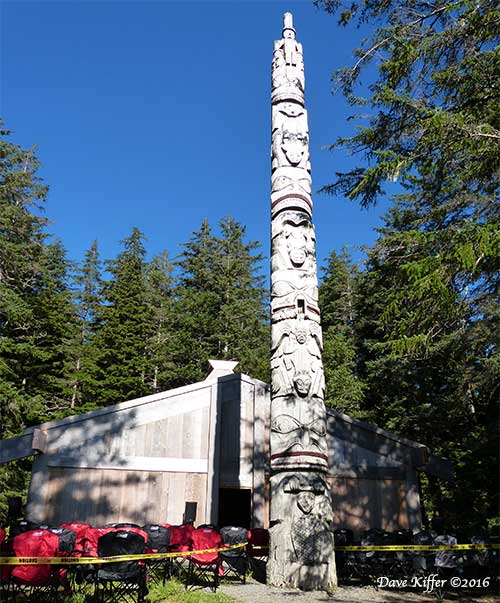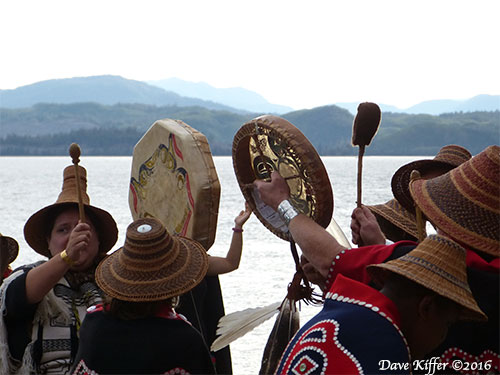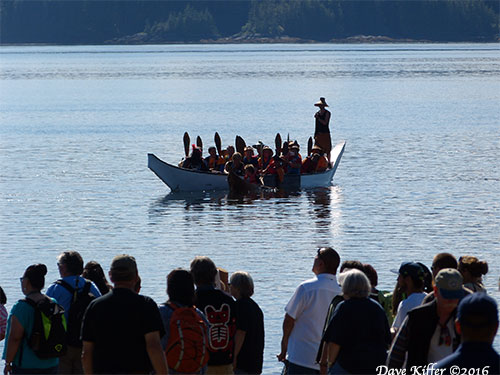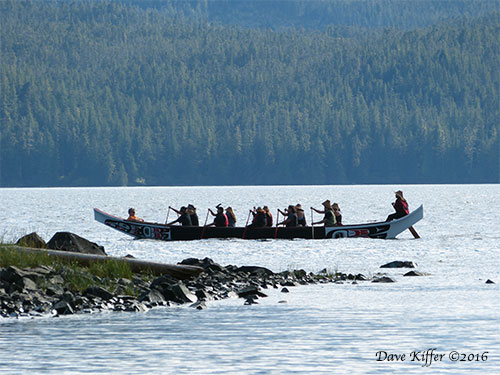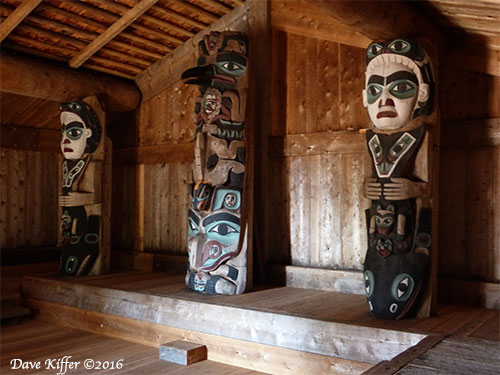
Kasaan celebrates Son-I-Hat longhouse restorationBy DAVE KIFFER September 14, 2016
The nearly 140-year-old longhouse, located at the end of a mile-long trail from the village, is on its second reconstruction, having been last restored in 1938. The carvers themselves say the restored longhouse recreates a "beacon" not just for Haida but for all people needing to reconnect with their lives.
Restoration of the Son-I-Hat longhouse in Kasaan, September 2016
The event was emceed by Hydaburg Mayor Anthony "Tony Peele" Christiansen and former longtime Kasaan leader Richard Peterson, the current head of the Tlingit-Haida Central Council in Juneau.
Greeting the Canoers Landing, September 2016
After the ceremony, there were several hours of dancing and music in the village. Ceremonial gifts were exchanged and the village somehow managed to come up with enough food to sate the hundreds of visitors, many of whom came from throughout Southeast and Haida Gwaii, the traditional home of the Haida who settled in the Kasaan area more than two centuries ago. According to the house history, provided by Haida Laas - Graham Richard: A Haida leader from the Yaadaa, a Kuusdek Eagle clan, set sail from the western part of Prince of Wales Island more than 200 years ago, with family members and friends in three canoes.
Canoers Landing, September 2016
The first Chief Son-I-Hat eventually passed on and his nephew, Koyongxung, who had been born in 1829, carried on his name. The new Son-I-Hat settled his family on the site of what became Gasa'aan, now known as Old Kasaan, some time before 1860. Old Kasaan, near the mouth of Polk Inlet, eventually held several other families and reached a size of 500 people, 18 houses and up to 60 totem poles. But a small pox epidemic struck the village in 1862, decimating the population down to 50 people, and Son-I-Hat chose to relocate near a Christian mission some 10 miles to the north. the Chief tried to convince his people to follow him, but many were concerned about living near the missionaries.
Canoers Arriving, September 2016 In 1880, Son-I-Hat constructed a new house, Naay I'waans. Also known as the Whale House or the House Without Nails. It was built in the traditional style. By 1902, the remaining residents of Old Kasaan had relocated to New Kasaan. The new house was 45 feet long, 45 feet wide and 25 feet tall. The 2025 square foot building sheltered more than 30 people including Son-I-Hat's family and three slaves. Eventually, as slavery was abolished in Alaska, the children of the slaves were adopted as family members. Son-I-Hat died at 83 in 1912. By the early 1930s, the Southeast weather had had nearly destroyed the 50 year old house. Only the corner posts and some beams remained. The federal Civilian Conservation Corps was hiring people during the Depression for public works projects and the Son-I-Hat house was restored. The CCC worked with Haida craftsmen to restore the house, using a crew of 20 workers, including eight carvers and carpenters. The work was led by James Peele, a direct descendant of Son-I-Hat.
Interior of the Son-I-Hat longhouse, September 2016
Eventually, other funders including the village Native corporation KAVILCO and the Rasmusen Foundation were brought in to help with the nearly $1 million in restoration costs. Work began in earnest in 2013, with lead carver Glenn "Stormy" Hamar, and apprentices Harley Holter-Bell, Eric Hamar and Justin Henricks working on the project. Initially, the crew was challenged to preserve as much of the existing building as possible, including 140 year old house posts and other parts that had been attacked by insects for decades. The work was long and arduous, each section of wood scarred with hundreds of adze marks in the traditional style “You can see all the adze marks on this building,” said Stormy Hamar during the ceremony. “We didn't count them, but there's somewhere around thirty-seven-hundred billion.”
Contact Dave at dave@sitnews.us
Dave Kiffer ©2016
Publish A Letter in SitNews Read Letters/Opinions
|
||
